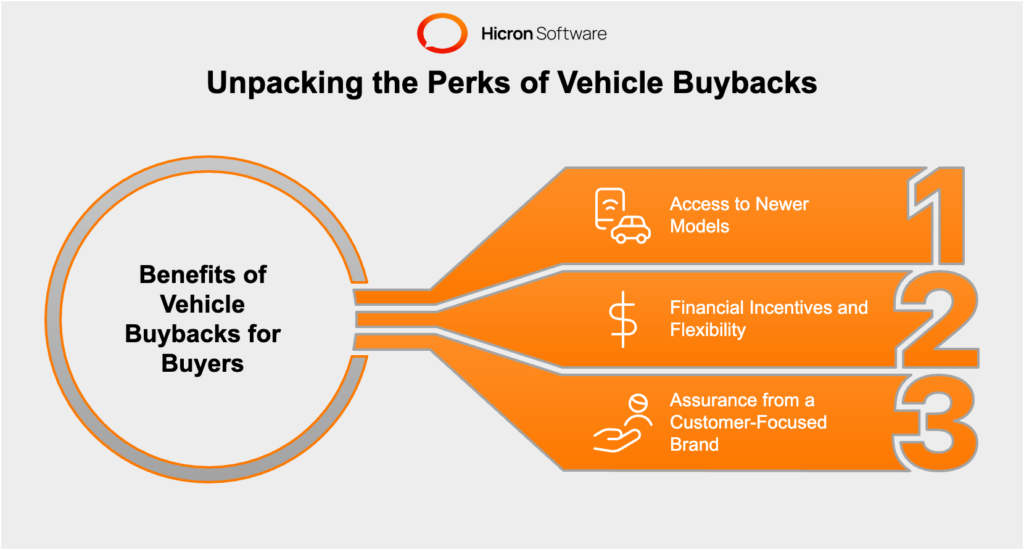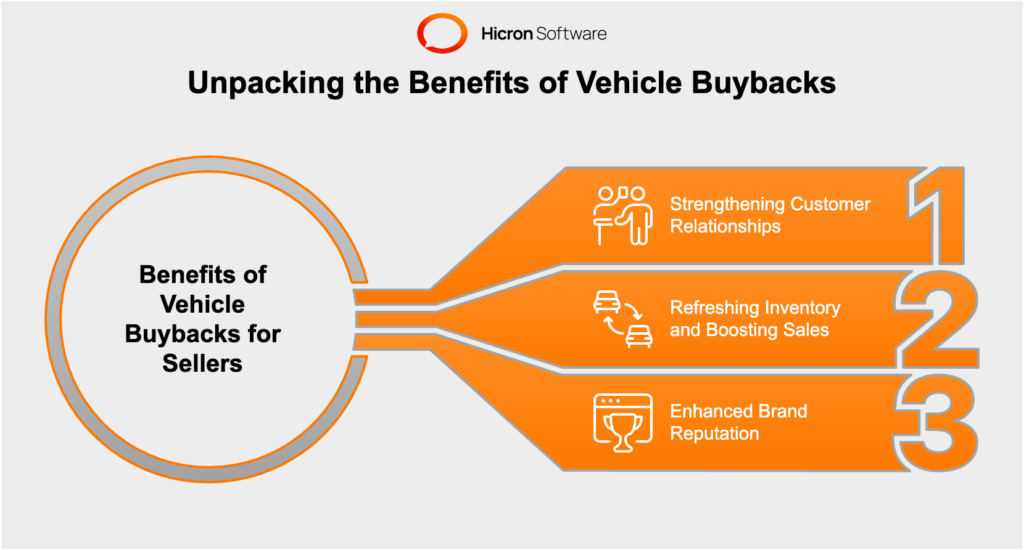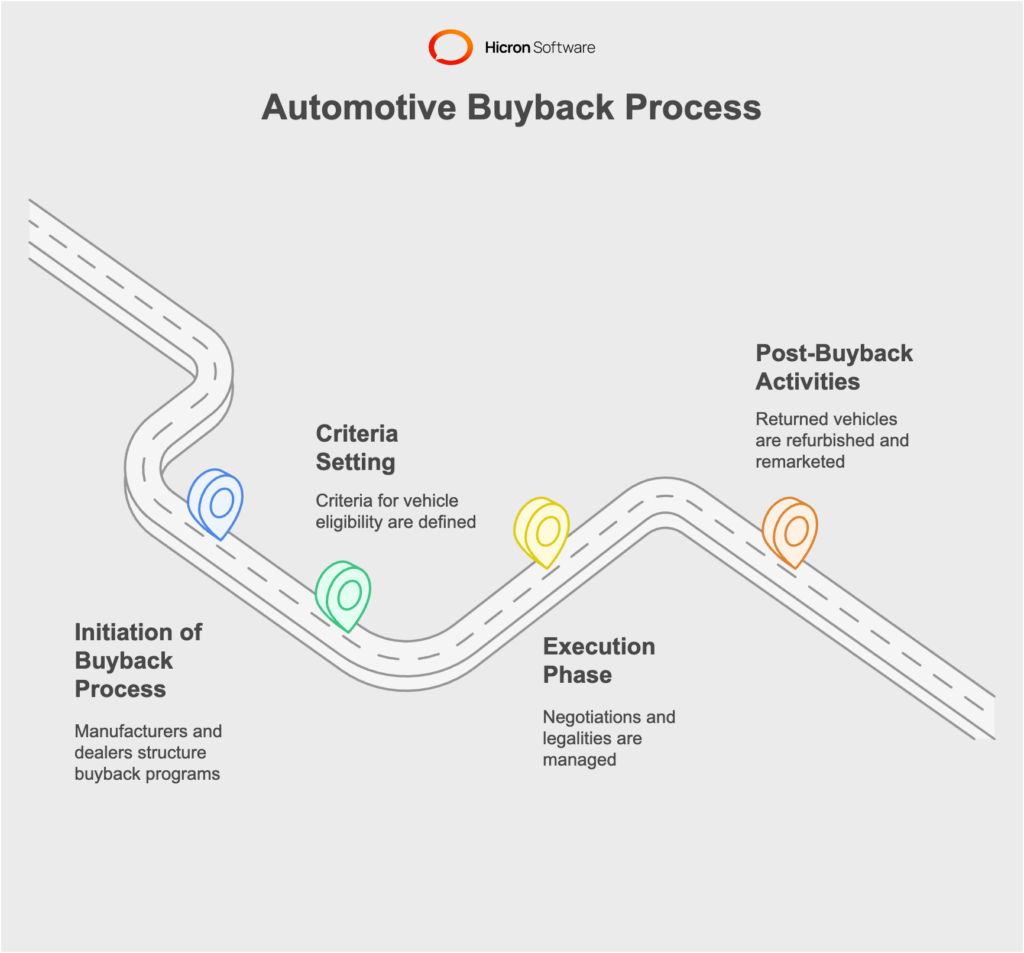Real-time Finance Offers: Revolutionizing the Automotive Buying Experience
- October 23
- 15 min

A car buyback program is when a car manufacturer or dealer buys back a vehicle from the customer. When a manufacturer or dealer buys back a car, they address customer concerns, build trust, and protect their reputation. This approach helps customers feel valued and satisfied, leading to stronger relationships and repeat business.
The purpose of this comprehensive guide is to explore the strategic use of vehicle buyback programs, providing valuable insights for both buyers and sellers. By understanding the nuances of a car buyback program, sellers can better manage inventory and customer relations, while buyers can make informed decisions that align with their needs and expectations. Whether you’re looking to sell a car back to the dealership or considering a purchase with a buy back guarantee, this guide equips you with the knowledge to confidently and clearly navigate the car buyback process.
When we talk about strategic car buybacks, we’re not focusing on lemon law buybacks, which address defects. Instead, a strategic car buyback program is a tool that dealerships and manufacturers use to keep operations smooth and customers happy. Think of it as a smart approach to inventory management that optimizes sales while promoting customer satisfaction.
These programs aren’t just about logistics; they’re about building loyalty. When a dealer buy back car program is offered, it reflects a commitment to customer-focused service. This gesture demonstrates value for the customers’ experience, strengthening trust and increasing the likelihood of future purchases or servicing. By implementing strategic car buyback programs, businesses create opportunities for growth, customer retention, and competitive advantage.
When it comes to car buyback programs, both buyers and sellers have something to cheer about. Let’s break down the perks on both sides of the table.


Car buybacks create a win-win situation for all involved. Buyers enjoy flexibility, financial incentives, and the assurance of dealing with a customer-centric brand, while sellers benefit from strengthened customer relationships, refreshed inventory, and an enhanced reputation. It’s a strategy that drives satisfaction and success in the automotive industry.
Navigating the car buyback process is like following a well-orchestrated playbook that ensures everything runs smoothly, from start to finish. Let’s break down the key stages: initiation, execution, and post-buyback.

A vehicle buyback program starts with setting clear criteria for eligibility. Factors like mileage, condition, and age are used to determine which cars to buy back. This structured approach ensures streamlined operations. Manufacturers and dealerships then advertise these opportunities to customers, delivering satisfaction while refreshing their inventory.
The execution phase involves collaboration between the buyer and the dealership or manufacturer. Whether it’s a dealer buy back offer or a truck buy back program, it’s critical to negotiate terms that are fair for everyone involved.
After a vehicle is brought back, it’s inspected, refurbished, and often prepared for remarketing through certified programs. A car buyback program doesn’t just end with the collection; it creates avenues for resale, maximizing value from every vehicle.
In essence, the car buyback process is a finely tuned-operation that requires careful planning and execution. By understanding each phase, from initiation through post-buyback activities, both buyers and sellers can enjoy a process that’s not only efficient but rewarding. This approach ensures that everyone benefits, keeping the wheels of the automotive industry running smoothly.
Navigating the world of car buybacks can be a rewarding journey for both buyers and sellers when approached with savvy strategies.
#1 Evaluating a car buyback offer: When a car buyback offer comes your way, take a moment to evaluate it thoroughly. Look beyond the surface and consider factors like the deal’s financial benefits and any potential trade-offs. Are you getting a fair trade-in value? Is there an opportunity to upgrade to a model that better suits your needs? Weighing these aspects carefully can help you maximize your benefits and minimize risks.
#2 Understanding terms and conditions: Before signing on the dotted line, ensure you fully understand the terms and conditions of the car buyback guarantee. This includes knowing any fees, the condition expectations for your vehicle, and the timelines involved. A favorable deal is one where you’re fully aware of what you’re agreeing to, so don’t hesitate to ask questions to clarify any points.
#1 Developing attractive car buyback offers: Crafting buy back programs for cars that resonate with your target customers is key. Consider what appeals to them—perhaps it’s the allure of new technology or competitive pricing. Tailor your offers to highlight these aspects, ensuring they stand out and entice customers to take action.
#2 Efficient management of logistics and operations: Once a buyback auto deal is accepted, the real work begins behind the scenes. Streamlining the logistics and operational side of the process ensures everything runs smoothly, from car retrieval to preparing it for resale. Efficient management not only saves time and resources but also enhances the customer experience.
#3 Leveraging customer feedback: Don’t overlook the treasure trove of insights customer feedback can provide. Post car buyback program gather feedback from participants to understand their experience and any areas for improvement. Use these insights to refine your car buyback strategies and enhance your products and services, continually meeting and exceeding customer expectations.
A car buyback program isn’t just a sales tool; it’s a strategy for mutual success. Buyback guarantees, proactive offers, and seamless processes bring dealers, manufacturers, and customers closer together. They also help dealerships manage inventory, enable smoother product launches, and build trust. Whether participating as a buyer or seller, these programs represent a high-value strategy for navigating a dynamic automotive market.
For anyone ready to explore innovative buy back solutions, the time to act is now. By implementing or participating in a car buyback program, you’re not merely buying or selling; you’re making a strategic investment in long-term satisfaction and success. Discuss your options with Hicron Software!
The buyback model is a strategy used by manufacturers or dealers to repurchase vehicles from customers. It helps manage inventory, launch new models, and build brand loyalty while providing customers with opportunities to upgrade their vehicles.
A buyback allows dealerships or manufacturers to refresh their inventory by repurchasing used vehicles. It enhances customer relationships, facilitates new model launches, and creates a win-win situation for both buyers and sellers.
Advantages:
Disadvantages:
A car buyback is when a manufacturer or dealer purchases a car back from a customer, often to address the customer’s concerns, improve trust, and maintain the company’s reputation.
No, a buyback and a lemon are different. A lemon buyback involves defective vehicles, whereas strategic car buybacks focus on managing inventory, refreshing stock, or fostering customer loyalty.
The process typically involves determining eligible cars based on set criteria (age, condition, mileage), negotiating terms with the customer, completing legal and financial transactions, and eventually refurbishing or reselling the vehicle.
A buyback is initiated by a dealer or manufacturer to repurchase vehicles, often for strategic reasons. A trade-in, on the other hand, is customer-initiated, where the customer exchanges their vehicle as partial payment for a new one.
Buybacks are generally beneficial for both parties. Sellers can manage inventory and maintain customer loyalty, while buyers enjoy financial incentives and easier upgrades to newer models.
Buybacks improve customer loyalty by showing that the manufacturer or dealer stands behind their products and is willing to address issues or offer upgrade opportunities.
Vehicles eligible for buybacks are often those with defects, recalls, or those that meet specific program criteria, such as age, mileage, or condition.
The buyback value is typically based on factors like the car’s age, condition, mileage, and market value at the time of purchase.
Bought-back cars are often refurbished and resold, used as loaner vehicles, or in some cases, dismantled for parts.
Brands or models facing widespread recalls, defects, or quality concerns are more likely to have buyback programs.
Recalls involve repairing a defect while the vehicle remains with the customer. Buybacks, on the other hand, involve the manufacturer or dealer repurchasing the car entirely.
Yes, customers can often negotiate aspects like the final valuation or additional perks like discounts on future purchases.
Buybacks help clear inventory of older models, encouraging customers to transition to new models while increasing dealership foot traffic.
Buybacks can temporarily increase the supply of used cars, potentially lowering prices, but refurbished buybacks may also enhance the quality of used car inventory.
Customers risk getting lower-than-expected valuations and may need to invest more to afford a replacement vehicle. Proper research and negotiation can help mitigate these risks.
